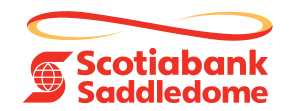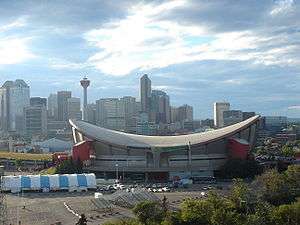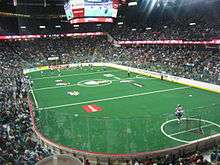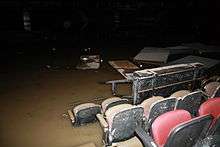Scotiabank Saddledome
 | |
 | |
| Former names |
Olympic Saddledome (1983–1995) Canadian Airlines Saddledome (1995–2000) Pengrowth Saddledome (2000–2010) |
|---|---|
| Address | 555 Saddledome Rise SE |
| Location | Calgary, Alberta |
| Coordinates | 51°02′15″N 114°03′07″W / 51.03750°N 114.05194°WCoordinates: 51°02′15″N 114°03′07″W / 51.03750°N 114.05194°W |
| Owner | City of Calgary |
| Operator | Saddledome Foundation/Calgary Flames LP |
| Capacity |
Ice hockey: 16,605 (1983–1988) 20,240 (1988–1995) 19,289 (1995–present) |
| Field size | 474,000 square feet (44,000 m2) |
| Construction | |
| Broke ground | July 29, 1981[1] |
| Opened | October 15, 1983 |
| Construction cost |
C$97.7 million ($213 million in 2016 dollars[2]) |
| Architect | Graham McCourt Architects |
| Structural engineer | Jan Bobrowski and Partners Ltd.[3] |
| Services engineer | Vinto Engineering Ltd.[4] |
| General contractor | CANA Construction Co. Ltd.[5] |
| Main contractors | SE Johnson (mechanical)[6] |
| Tenants | |
|
Calgary Flames (NHL) (1983–present) Calgary Hitmen (WHL) (1995–present) Calgary Roughnecks (NLL) (2001–present) Calgary Outlaws (NBL) (1994) Calgary Rad'z (RHI) (1993) Calgary 88s (WBL) (1988–1992) | |
The Scotiabank Saddledome is the primary indoor arena of Calgary, Alberta, Canada.
Located on the Stampede Grounds, on the southeast end of downtown Calgary, the Saddledome was built in 1983 to replace the Stampede Corral as the home of the Calgary Flames of the National Hockey League, and to host ice hockey and figure skating at the 1988 Winter Olympics. Today the arena is also home to the Calgary Hitmen of the Western Hockey League and the Calgary Roughnecks of the National Lacrosse League.
The facility also hosts concerts, conferences and other sporting championships, and events for the Calgary Exhibition and Stampede. It underwent a major renovation in 1994–95 and sold its naming rights, during which its original name of Olympic Saddledome was changed to Canadian Airlines Saddledome. The facility was given the name Pengrowth Saddledome in 2000, after Pengrowth Management Ltd. signed a ten-year agreement. It adopted its current name in October 2010 as Scotiabank signed on as title sponsor.
The Saddledome is owned by the City of Calgary who leased it to the Saddledome Foundation, a non-profit organization, to oversee its operation. It is currently managed by the Calgary Flames.
The Saddledome was damaged during the 2013 Alberta floods but was repaired and reopened in time for the 2013–14 NHL season.
Calgary Stampede
Calgary had been served for 30 years by the Stampede Corral when the Calgary Flames arrived in 1980. With a total capacity of 8,700, the Corral was the largest arena in Canada west of Toronto in 1950,[7] but had fallen below major league standards by the 1970s. The Corral was deemed insufficient for the National Hockey League (NHL) in 1977, leading the World Hockey Association's Calgary Cowboys to fold rather than hope to be a team selected to merge with the NHL.[8]
Calgary's bid to host the 1988 Winter Olympics, coupled with the arrival of the Flames, drove the need to build a new arena. City Council debated the merits of several locations for the city's new Olympic Coliseum, and narrowed their choices down to two areas in the Victoria Park neighbourhood on the east end of downtown.[9] Two other sites, one on the west end of downtown, and a late bid by several businessmen pushing to build the arena in the northern suburb of Airdrie were also considered.[10]
The Victoria Park Community Association fought the bid to build the arena in their neighborhood, threatening to oppose the city's Olympic bid if necessary.[11] City Council voted on March 3, 1981 to build the proposed 20,000 seat arena on the Stampede grounds, immediately east of the Corral and south of Victoria Park.[12] The community continued to fight the city over rezoning the land to allow for the new arena amidst fears of traffic congestion in their neighbourhood which resulted in numerous costly delays to the start of construction.[13] In a bid to end the battle, Mayor Ralph Klein asked the provincial government in July 1981 to take over the land designated for the arena to bypass the appeals process and force approval.[14] The province supported the city amidst protests by community associations and invoked rarely used powers to overrule planning regulations, allowing construction to begin.[15] The following day, on July 29, 1981, builders began construction of the arena.[16] The International Olympic Committee was impressed that the project was underway, as noted in the XV Olympic Winter Games official report which stated "The fact that this facility was already being built added credibility to (Calgary's) bid and proved to be a positive factor in demonstrating Calgary's commitment to hosting the Games".[17]
The facility was designed by Graham McCourt Architects. While they set out to design a unique building, the idea of a western theme never occurred to Barry Graham or his team.[17] The roof of the building was designed to be a reverse hyperbolic paraboloid, allowing for a pillar free view from all seats and reducing the interior volume by up to one-third when compared to traditional arenas,[18] resulting in reduced heating, lighting and maintenance costs, plus the floating roof can flex to compensate for the city's frequent temperature fluctuations.[17] When the design was unveiled, the roof was immediately referred to as being saddle-shaped. Of 1,270 entries submitted in a contest to name the arena, 735 involved the word Saddle. The winning name in the contest, Olympic Saddledome, was drawn from a hat filled with several similar saddle-themed names. At the time the name received a tepid reception from some, including the chairman of Calgary's Olympic Organizing Committee (OCO), Frank King, who was quoted as saying "It is neither Olympic nor western, and it's not even dome".[17]
The designers won several architectural and engineering awards for their work on the Saddledome,[17] and were honoured by the Royal Architectural Institute of Canada at its millennium celebration of architecture in 2000.[19] As of 2008, the Saddledome was still reported as the world record holder for the longest spanning hyperbolic paraboloid concrete shell.[17] The Saddledome was featured on the cover of Time Magazine on September 27, 1987, for an article discussing the city of Calgary and the upcoming 1988 Olympics.[20]
The location of the Saddledome within Stampede Park allows for easy access to Calgary's C-Train light rail transit system via the Victoria Park/Stampede station that stands parallel to Macleod Trail. The C-Train station, BMO Centre, Stampede Corral and Saddledome are all connected via a Plus 15 pedestrian skyway. Direct vehicle access is gained from the north via 5th Street East or Olympic Way.[21]
History

The arena was initially projected to cost $60 million to build,[16] and later revised to over $80 million.[22] Attempts to fast track construction resulted in a $16 million cost overrun, resulting in a final cost of $97.7 million and an eight-month delay in its completion.[17] Builders faced delays while building the roof as numerous adjustments were required to fit the giant concrete slabs between the array of cables that held them in place.[23] Upset with the excess cost, opposition politicians in Alberta demanded a public hearing into the issue.[24] A hearing conducted by the city placed much of the blame on the project manager, while the city and province were required to pay the additional costs.[25]
When it opened on October 15, 1983, the Olympic Saddledome served to boost the morale of a city that was experiencing a significant downturn as a result of the international oil market collapse, high interest rates, and the federal government's National Energy Policy.[17] During the first event, an NHL game between the Flames and the Edmonton Oilers, the standard of Prime Minister Pierre Trudeau was the first thing booed by a population upset with the government's policies.[26] The Oilers defeated the Flames 4–3 in front of a sold out crowd of nearly 17,000 fans.[27]
The initial seating capacity was 16,605 for hockey as the upper loges were not immediately completed.[28] As the Olympics neared, the Calgary organizing committee spent $1 million to add over 2,600 seats to the upper loges in a bid to alleviate a scandal that resulted from the organizing committee giving its partners and sponsors preferential treatment in ticket sales.[29] With a capacity of 20,016, the International Ice Hockey Federation noted that it was the largest arena ever used at the Winter Games, and called the facility "the finest international rink in the world"[30] The International Olympic Committee praised the city's commitment to hosting the Olympics, noting in its official report that constructing the arena prior to being awarded the Games lent credibility to Calgary's bid and positively influenced voters.[17] The Saddledome was the first arena in North America designed to accommodate the larger international ice surface[31] (international rinks are 13 feet wider than NHL rinks). The Saddledome reached its highest capacity in the early '90s at 20,230.

The Flames petitioned the City of Calgary and the Saddledome Foundation to upgrade the facility in 1994, requesting renovations to add additional luxury boxes and a new club section. The Flames insisted the upgrades were necessary for the team to remain viable in the arena. They argued it was important that their landlord bring the arena up to the higher standards they felt was required.[32] The team lobbied City Council in the hope it would agree to fund the majority of the $18 million renovation using federal infrastructure funds. At the same time, they rejected a counter proposal for applying a ticket surcharge to pay the cost.[33] Media reports claimed the team was considering relocating out of Calgary if council did not agree. Flames' owners denied the reports, but said they had threatened to build a new rink elsewhere in the city.[32] City Council supported the Flames' proposal in a 9–6 vote following several months of negotiations.[34]
Renovations occurred between 1994 and 1995 and saw the addition of 41 new luxury suites at the top of the lower bowl, an 1,172 seat club section, a new restaurant, expanded offices for the Flames, Saddledome management and Hockey Canada, as well as a significant restructuring of the public concourse and a new parkade structure.[35] The arena remained operational until the spring of 1995 despite ongoing construction, but was closed entirely between April and October 1995.[36] The Saddledome officially re-opened on October 25, 1995 for the Flames' first home game of the 1995–96 NHL season.[37]
Prior to its re-opening, the Flames signed a deal with Canadian Airlines to rename the facility. Under a twenty-year agreement worth approximately $1 million per year, the arena became the Canadian Airlines Saddledome. Removing the "Olympic" moniker was controversial with both the public and City Council, though the city voted in favour of the deal which included the donation of a portion of the naming rights to fund amateur sports within the city.[38] The arena was renamed again in 2000 when Canadian Airlines was acquired by Air Canada and ceased operations. Pengrowth Management Ltd. signed a ten-year agreement that gave the facility the name of Pengrowth Saddledome.[39]
The arena has received cosmetic upgrades in recent years. In 2004, the Flames spent $1 million on a LED "power ring" display that lines the facing of the second level. The JumboTron that was installed in 1995 was replaced in 2006 with a new high definition scoreboard.[40] Manufactured by Daktronics, the display has twelve screens and two LED ribbons,[41] and is called the Enmax Energy Board.[40]
2013 flood

The Saddledome was one of many buildings impacted by the 2013 Alberta floods. The flooding of the Elbow and Bow Rivers swamped many areas of the city, including Stampede Park where the Saddledome is located. The event level of the arena was filled with water, also wrecking the high definition scoreboard that had been sitting on the rink floor during the summer downtime, while the dressing rooms and control room for the video replay screen were swamped.[42] At a press conference held on June 22, 2013, team president Ken King stated that the arena had flooded up to the eighth row and that the event level of the facility was a "total loss". He added that the team's equipment and some memorabilia had also been destroyed, but expressed confidence that the facility would be repaired and ready in time for the October start to the 2013–14 Calgary Flames season.[43] Repairs to the facility forced the cancellation of all concerts and agricultural events scheduled for the 2013 Calgary Stampede.[44]
Crews worked around the clock to repair the facility; Saddledome director of building operations Robert Blanchard estimated that 650,000 man hours of work was performed on the facility and noted that they had compressed a six-month project into two. The facility was granted its occupancy permit in late August, and the first event following the Saddledome's re-opening was an Eagles concert on September 11. The first hockey game was September 14, a Flames pre-season contest.[45]
Events
As the home of the Flames, the Saddledome hosted the 1985 NHL All-Star Game,[46] and the 2000 NHL Entry Draft.[47] The Flames have played three Stanley Cup Finals series in the Saddledome: 1986, 1989 and 2004.[48] The arena is also the home of the Calgary Hitmen of the Western Hockey League (WHL). The Hitmen won the President's Trophy in 1999 before a WHL playoff record crowd of 17,139.[49] Playing in the largest arena in the WHL,[50] the Hitmen also hold league records for overall attendance (362,227 in 2004–05),[51] as well as single game (19,305 in 2007–08).[52] The Saddledome is also the home of the Calgary Roughnecks of the National Lacrosse League (NLL) and hosted the 2005 NLL All-Star Game.[53] It has twice hosted the NLL Champion's Cup game: 2004 and 2009, both Calgary victories.[54] The stadium was one of the venues for the 2012 World Junior Ice Hockey Championships.
The opening of the Saddledome allowed Calgary to play host to major musical acts that were bypassing the city in the early 1980s, because the city's existing facilities were not large enough to accommodate the industry's top performers.[55]
The Moody Blues were the first musical act to appear with Stevie Ray Vaughan opening, in November 1983, while Rod Stewart has made the most appearances in the Dome, 11.[56] Many other top acts have made stops in the Saddledome, however the inability of the roof to support the massive light, speaker and special effect rigs that some performers currently use has led the city to again be bypassed for some major tours.[57]
In addition to hockey and figure skating at the 1988 Olympics,[58] the Saddledome has been the site of numerous major national and international events. The facility has hosted Brier, the Canadian men's curling championship, on four occasions (1997, 2002, 2009 and 2015).[59] It also hosted the women's championship, the Tournament of Hearts in 1995.[60] The 2006 World Figure Skating Championships was also held in the arena.[61] The WWF pay-per-view event In Your House 16: Canadian Stampede was also held at the Saddledome in July 1997. Among non-sporting events, the Saddledome most recently hosted a public address by the Dalai Lama in 2009 that was attended by 15,000 people.[62] In 2005, Queen Elizabeth II attended a celebration of Alberta's centennial at the Saddledome.
It has also hosted PBR Bud Light Cup events; in 1998 and 1999 the event was known as "Cody Snyder's Bullbustin'", and in 2000 and 2001 the event was called the Professional Bull Riders Canadian Open. The Saddledome has also been a host for PBR Canada[63] events.
On October 3rd, 2016, the Saddledome hosted a National Basketball Association preseason game between the Toronto Raptors and Denver Nuggets.
Amenities
The Saddledome seats 19,289 for hockey and lacrosse, with different capacities for other events depending on the arena's configuration.[64] It has 72 luxury suites,[17] 41 of which were constructed at the top of the lower bowl in 1995 and 31 were constructed at the top of the second level when the facility was built.[33] There are also six party suites on the corners of the upper loges that are rented on an event by event basis.[65] Sections 115 through 122 of the lower bowl form the Chrysler Club and offers in-seat concession service at Flames games.[66][67]
The Chrysler Club features a private dining room available during Flames games, large concerts and private events.[68] Dutton's Canadian Lounge is a sports bar located at the west entrance to the building.[69] There are three additional restaurants within the facility: The HSBC Saddleroom Restaurant, the Alumni Lounge and the King Club.[68] The Iconic Platinum Club is a 188-seat executive club accessible with a purchased membership. It features a private bar and restaurant as well as a fully functional business centre.[70]
Saddledome Foundation
The City of Calgary established the Saddledome Foundation in 1983 and leased the arena for 50-years to the non-profit organization. Its mandate was to "oversee the operation in a manner that protects taxpayers and benefits amateur sports at the local, provincial and national level".[35] The foundation is made up of a board of nine directors: three appointed by the city, three appointed by the province, and one each appointed by the Calgary Olympic Development Association (now WinSport Canada), Hockey Canada and the Calgary Exhibition and Stampede.[71] The foundation contracted the Stampede to manage the arena, and through its lease agreements with the Stampede and the Flames, earned 15% of gross concession sales, 50% of net income from luxury suites and executive seating and investment income on the arena's revenues.[35] The Flames signed a 20-year lease in 1983 that earned them 70% of advertising revenues and 90% of ticket revenues. The Stampede earned 85% of concession revenues and all revenue from parking.[35]
As part of the 1994 deal with the city, the Flames bought out the Stampede's contract for $20 million and took over management of the facility.[33] While the city and Saddledome Foundation paid for the 1994–95 renovations, the new agreement required the Flames to pay for future arena maintenance and repairs, as well as any further renovations.[35] The Flames agreed to manage the arena for 20 years and to contribute $14.5 million toward amateur sport in the city over that time.[33] The Saddledome Foundation retains the responsibility of distributing funds to amateur sport. From its inception through 2007, it had allocated over $20 million toward this cause.[72]
Future
The Saddledome is one of the oldest arenas in the NHL, fueling speculation that it is due to be replaced.[57] Flames president and chief executive officer Ken King said in 2008 that plans for a new arena were "five to eight years away" creating the expectation that the team hoped to have a new arena built for when their lease was due to expire in 2014, but such plans never came to fruition.[73] Team chairman Murray Edwards argues that the ability of the facility to host major events and concerts are growing increasingly limited as the facility ages. Along with Edwards, sports financial analysts also note that newer arenas generate far more revenue for their teams than the Saddledome does for the Flames.[57]
It is expected that any new arena would also be located either on the Stampede Grounds or elsewhere in downtown Calgary.[57] While NHL Commissioner Gary Bettman has lobbied on behalf of both the Flames and the Oilers for government support,[57] Calgary mayor Naheed Nenshi and alderman John Mar have stated their opposition using taxpayer money to help fund a new arena.[74][75] King stated that the Flames have concepts and designs for a new building, but are not ready to release them.[17] Some of the plans being considered for Stampede Park would include lowering the city's C-train light rail transit line below ground and run straight into a new facility.[57]
A new arena is being proposed as part of CalgaryNEXT—a sports complex which would be located in the western downtown area, and would include replacements for both the Saddledome and McMahon Stadium.[76]
See also
- Arizona Veterans Memorial Coliseum
- Capital Centre
- London Velopark
- Hyperboloid structure
- Tensile architecture
- Thin-shell structure
- List of indoor arenas in Canada
References
- ↑ "Archives". Archivesalberta.org. 1983-10-15. Retrieved 2013-02-22.
- ↑ Canadian inflation numbers based on Statistics Canada. "Consumer Price Index, historical summary". CANSIM, table (for fee) 326-0021 and Catalogue nos. 62-001-X, 62-010-X and 62-557-X. And Consumer Price Index, by province (monthly) (Canada) Last modified 2016-01-22. Retrieved March 2, 2016
- ↑ "CPCI History – CPCI – Canadian Precast Prestressed Concrete Institute www.cpci.ca". Cpci.ca. Archived from the original on 2010-08-29. Retrieved 2013-02-22.
- ↑ The Saddledome: the Olympic ice stadium in Calgary
- ↑ https://news.google.com/newspapers?id=xwNlAAAAIBAJ&sjid=mH4NAAAAIBAJ&pg=5707,2954678&dq=en
- ↑ SE Johnson
- ↑ Toth, Dan (2005-02-12). "Shootout at the Stampede Corral". Calgary Sun. p. 10.
- ↑ Zeman, Gary (1985). Alberta on Ice. GMS Ventures. p. 90. ISBN 0-9692320-0-4.
- ↑ Pratt, Sheila (1981-03-03). "Coliseum decision today — east end has edge". Calgary Herald. p. A1.
- ↑ Tennant, Jack (1981-02-12). "Airdrie logical site for coliseum". Calgary Sun. p. 5.
- ↑ St. Laurent, Steve (March 2, 1981). "Residents will fight coliseum". Calgary Herald. p. A1.
- ↑ Warden, Kathryn (1981-03-04). "Stampede picked for coliseum". Calgary Herald. p. A1.
- ↑ Pratt, Sheila (1981-07-25). "Klein tries end run in coliseum battle". Calgary Herald. p. A1.
- ↑ Cotton, Crosbie (1981-07-28). "Klein's action may guarantee Games". Calgary Herald. p. B1.
- ↑ "Final hurdle is cleared for coliseum". Calgary Herald. 1981-07-29. p. A1.
- 1 2 Cotton, Crosbie (1980-07-30). "Work starts on coliseum site". Calgary Herald. p. B1.
- 1 2 3 4 5 6 7 8 9 10 11 Remington, Robert (2008-10-12). "Sensational Saddledome helped define Calgary". Calgary Herald. p. A3. Retrieved 2008-10-21.
- ↑ "Building Design". Saddledome Foundation. Retrieved 2008-10-21.
- ↑ "Olympic Saddledome". Alberta Association of Architects. Archived from the original on 2008-04-16. Retrieved 2010-01-16.
- ↑ "Welcoming the world". Time Magazine: cover. 1987-09-27. ISSN 0040-781X.
- ↑ "Stampede Park map" (PDF). Government of Alberta. Retrieved 2010-01-16.
- ↑ "Saddledome's a cinch to please". Calgary Herald. 1983-10-15. p. G1.
- ↑ "Calgary Saddledome: 10 months overdue, $16.5 million over". New London Day. 1983-09-20. p. 38. Retrieved 2010-01-16.
- ↑ Rose, Michael (1983-07-30). "Calgary Olympics: Trying to avoid Montreal's example". Montreal Gazette. p. B5. Retrieved 2010-01-16.
- ↑ Adams, Jeff (1984-10-16). "Report questions Olympic chief's competence". Ottawa Citizen. p. C1. Retrieved 2010-01-16.
- ↑ Wood, Larry (1983-10-16). "Glass, pigeons crash opening clambake". Calgary Herald. p. E1.
- ↑ Duhatschek, Eric (1983-10-16). "Saddledome infested with 'Rat'". Calgary Herald. p. E1.
- ↑ Mummery, Bob (1989). Countdown to the Stanley Cup. Polestar Book Publishers. p. 39. ISBN 0-919591-48-5.
- ↑ Reed, J.D. (1987-09-27). "Games on the range". Time Magazine: 17. ISSN 0040-781X.
- ↑ Podnieks, Andrew. Canada's Olympic Hockey History 1920–2010. Toronto: Fenn Publishing. p. 149. ISBN 1-55168-323-7.
- ↑ "Scotiabank Saddledome". ESPN. Retrieved 2011-10-30.
- 1 2 "Moving never option, Doc Seaman claims". Calgary Herald. 1994-08-09. p. A1.
- 1 2 3 4 Stelnhart, David (1994-03-22). "Council approves Saddledome deal". Calgary Herald. p. A1.
- ↑ Megrath, Vickie; Miller, Mark (1994-03-22). "Council OK's 'Dome deal". Calgary Sun. p. 4.
- 1 2 3 4 5 "Dome improvement". Calgary Sun. 1994-03-20. p. 17.
- ↑ Stewart, Monte (1994-08-10). "It's chaos, but the shows go on". Calgary Herald. p. A1.
- ↑ "Flames history". Calgary Flames Hockey Club. Retrieved 2010-01-20.
- ↑ Dolik, Helen (1995-07-19). "Deal made to rename 'Dome". Calgary Herald. p. A1.
- ↑ Francis, Eric (2000-06-30). "That's the ticket!". Calgary Sun. Retrieved 2010-01-16.
- 1 2 "Lights out for JumboTron". Calgary Herald. 2006-12-13. Retrieved 2010-01-23.
- ↑ "Photo Gallery – Saddledome". Daktronics. Retrieved 2010-01-23.
- ↑ "Saddledome, Stampede Grounds hit by flooding in Alberta". The Sports Network. 2013-06-21. Retrieved 2013-06-21.
- ↑ "Flames say lower part of Saddledome 'total loss' from flooding". Canadian Broadcasting Corporation. 2013-06-22. Retrieved 2013-06-22.
- ↑ Toneguzzi, Mario (2013-07-02). "Kiss, Jepsen, Dixie Chicks, Saddledome concerts cancelled by Calgary Stampede". Calgary Herald. Retrieved 2013-07-02.
- ↑ "Saddledome prepares to host concerts, hockey after flood". The Sports Network. 2013-09-05. Retrieved 2013-09-05.
- ↑ Duhatschek, Eric (1985-02-13). "Lemieux shrugs off sour Grapes". Calgary Herald. p. E1.
- ↑ Wigge, Larry (2000-06-26). "Rolling the dice". The Sporting News. Retrieved 2010-01-16.
- ↑ Hanlon, Peter; Kelso, Sean (2009). 2009–10 Calgary Flames Media Guide (PDF). Calgary Flames Hockey Club. pp. 8–9.
- ↑ Sportak, Randy. "Memorial Drive". Calgary Herald. p. S2.
- ↑ Flett, Cory; Watts, Jessie (eds.). 2008–09 WHL Guide. Western Hockey League. pp. 33–138.
- ↑ Flett, Cory; Watts, Jessie (eds.). 2008–09 WHL Guide. Western Hockey League. p. 219.
- ↑ "Calgary Hitmen set new attendance record". Western Hockey League. 2008-03-17. Archived from the original on June 17, 2015. Retrieved 2010-01-16.
- ↑ "League history (select 2005 from drop down menu)". National Lacrosse League. Retrieved 2010-01-16.
- ↑ "Roughnecks defeat Titans to win second NLL championship". The Sports Network. 2009-05-16. Retrieved 2010-01-16.
- ↑ McCoy, Heath (2008-10-13). "'Dome saddles up big acts". Calgary Herald. p. C1.
- ↑ "By the numbers". Calgary Herald. 2008-10-12. p. A3.
- 1 2 3 4 5 6 Fekete, Jason (2009-04-12). "Is the sun setting on Alberta's NHL rinks?". Calgary Herald. p. B1.
- ↑ 1988 Winter Olympics official report. Part 1. pp. 152-7.
- ↑ "Calgary to Stage 2009 Tim Hortons Brier; Tim Hortons Renews Sponsorship Through 2010". Canadian Curling Association. 2007-10-12. Archived from the original on February 20, 2010. Retrieved 2010-01-23.
- ↑ "Veterans will fight it out at Tournament of Hearts". Kitchener Record. 1995-01-31. p. D2.
- ↑ "ISU World Figure Skating Championships 2006". International Skating Union. Retrieved 2010-01-23.
- ↑ "Dalai Lama talks peace in Calgary". Canadian Broadcasting Corporation. 2009-09-30. Retrieved 2010-01-23.
- ↑ Tyler Thomson. "Home". PBR Canada. Retrieved 2013-02-22.
- ↑ "Saddledome A to Z (S)". Saddledome Foundation. Retrieved 2010-01-23.
- ↑ "Luxury suites". Calgary Flames Hockey Club. Archived from the original on 2010-02-03. Retrieved 2010-01-23.
- ↑ "Seating map and pricing". Calgary Flames Hockey Club. Archived from the original on 2010-01-07. Retrieved 2010-01-23.
- ↑ "Saddledome A to Z (C)". Saddledome Foundation. Retrieved 2010-01-23.
- 1 2 "The Avison Young Club". Saddledome Foundation. Retrieved 2010-01-23.
- ↑ "Dutton's Canadian Lounge". Saddledome Foundation. Retrieved 2010-01-23.
- ↑ "Fairmont Platinum Club". Saddledome Foundation. Retrieved 2010-01-23.
- ↑ "Saddledome Foundation". Saddledome Foundation. Retrieved 2010-01-20.
- ↑ "2005/2006 Board of Director's annual report" (PDF). Saddledome Foundation. 2007. Retrieved 2010-01-20.
- ↑ Sportak, Randy (2008-08-23). "Home sweet 'Dome no more?". Calgary Sun. Retrieved 2008-10-23.
- ↑ Allan Maki & Dawn Walton (1 February 2013). "Calgary Flames keeping a low profile on plans to replace Saddledome". Globe and Mail. Calgary. Retrieved 2 February 2013.
- ↑ Logan, Shawn (2008-10-23). "Timeline frozen for new arena". Calgary Sun.
- ↑ Toneguzzi, Mario (August 19, 2015). "Flames' aspirations were just too big for Stampede Park". Calgary Herald. p. A6. Retrieved August 27, 2015.
External links
| Wikimedia Commons has media related to Scotiabank Saddledome. |

